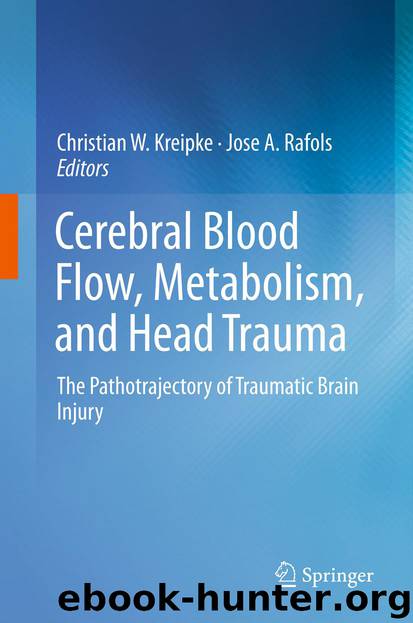Cerebral Blood Flow, Metabolism, and Head Trauma by Christian W. Kreipke & Jose A. Rafols

Author:Christian W. Kreipke & Jose A. Rafols
Language: eng
Format: epub
Publisher: Springer New York, New York, NY
4.4.6.2 Arterial Spin Labeling
ASL is an arterial spin tagging technique that relies on the detection of magnetically labeled blood. Once the magnetization of the inflowing arterial blood has been modified (generally inverted) upstream, it induces a small MR signal change downstream (a few percent of the tissue magnetization). Meanwhile, the magnetization of the perfusion tracer (i.e., the labeled water) is rapidly relaxing. Return of the longitudinal magnetization toward its equilibrium values takes a few seconds. Although ASL techniques have not entered widespread clinical usage, their utility has been demonstrated for a variety of acute and chronic cerebrovascular diseases such as stroke and epilepsy. (Wintermark et al. 2005). One significant advantage of ASL is the ability to perform multiple repeated measurements without the use of a contrast agent. This might be necessary before and after treating the patient with a cerebrovascular dilator (acetazolamide) or vasoconstrictor inhibitor (clazosentan), for example. Kim et al. used ASL to measure the resting state CBF in 28 moderate to severe TBI patients in the chronic stage and found that (a) there was a global decrease of CBF compared to controls and (b) prominent regional hypoperfusion was present in the posterior cingulate cortices, the thalami, and multiple locations in the frontal cortices (Kim et al. 2010). However, in the population of mTBI, how cerebral perfusion is being affected in patients and their association with patients’ neurocognitive status is still not understood. Given the milder severity in mTBI patients, perfusion imaging at the acute stage could be meaningful both for clinical decision-making and patients’ outcome prediction. Ge et al. also employed ASL to study 21 mTBI patients at the chronic stage and demonstrated reduced CBF in both sides of the thalamus, which is correlated with the patients’ speed of information processing, memory, verbal, and executive function (Ge et al. 2009). ASL has also been used in conjunction with functional brain imaging studies and with animal studies, but these directions are outside the scope of the material presented in this chapter. However, some of the fMRI/ASL research does suggest that there are reductions in CBF that may be related to diffuse pathology.
Download
This site does not store any files on its server. We only index and link to content provided by other sites. Please contact the content providers to delete copyright contents if any and email us, we'll remove relevant links or contents immediately.
Periodization Training for Sports by Tudor Bompa(8170)
Bodyweight Strength Training by Jay Cardiello(7841)
Born to Run: by Christopher McDougall(7064)
Inner Engineering: A Yogi's Guide to Joy by Sadhguru(6725)
Asking the Right Questions: A Guide to Critical Thinking by M. Neil Browne & Stuart M. Keeley(5635)
The Fat Loss Plan by Joe Wicks(4847)
Bodyweight Strength Training Anatomy by Bret Contreras(4612)
Yoga Anatomy by Kaminoff Leslie(4306)
Dynamic Alignment Through Imagery by Eric Franklin(4118)
Science and Development of Muscle Hypertrophy by Brad Schoenfeld(4089)
ACSM's Complete Guide to Fitness & Health by ACSM(3989)
Exercise Technique Manual for Resistance Training by National Strength & Conditioning Association(3955)
The Four-Pack Revolution by Chael Sonnen & Ryan Parsons(3932)
Bodyweight Strength Training: 12 Weeks to Build Muscle and Burn Fat by Jay Cardiello(3915)
The Ultimate Bodybuilding Cookbook by Kendall Lou Schmidt(3886)
Yoga Anatomy by Leslie Kaminoff & Amy Matthews(3863)
American Kingpin by Nick Bilton(3757)
Nutrition for Sport, Exercise, and Health by Spano Marie & Kruskall Laura & Thomas D. Travis(3715)
Yoga Therapy by Mark Stephens(3702)
